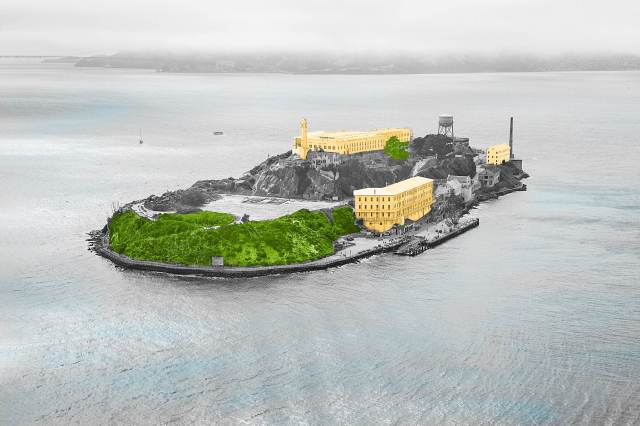
The Word “Alcatraz” Means “Pelican” in Archaic Spanish
In 1775, Spanish explorer Juan Manuel de Ayala became the first European to sail into San Francisco Bay. He named the bay and its islands, including one he called “Alcatraces.” Although the island’s name was anglicized over the decades, its origin is widely believed to mean “pelican” or “strange bird.” The island was once a particular hot spot for California brown pelicans (Pelecanus occidentalis californicus), which were so plentiful in the 19th century that one French observer noted that when a group of pelicans took off in flight, it created winds like a hurricane. Although the birds’ numbers dwindled sharply due to hunting and the use of DDT over the decades, the pelican rebounded in the latter part of the 20th century, and was removed from the Endangered Species List in 2009.

Before Becoming a Prison, Alcatraz Was a Military Outpost
Although Alcatraz is known as one of America’s most infamous prisons, its first official U.S. role was as a military outpost. With California joining the U.S. in 1850 after being ceded from Mexico two years prior, and with hundreds of thousands of people flooding the state as part of the California Gold Rush, the U.S. military needed to protect San Francisco Bay. Alcatraz, along with Fort Point and Lime Point, formed a “triangle of defense” that guarded the bay’s entrance. At one point, the U.S. even installed 100 cannons on the 22-acre island, making it the most heavily armed military outpost in the Western U.S. But by the decade’s end, the first prisoners had been brought to the island, and Alcatraz played host to both Confederate prisoners and Union deserters during the Civil War.

Alcatraz Was Home to the First Lighthouse on the U.S. West Coast
During the island’s days as a military outpost, the U.S. constructed a lighthouse to serve vessels crisscrossing the busy shipping lanes of San Francisco Bay. Although the lighthouse tower was built by 1852, the Fresnel lens — a compact lens designed to make lighthouses brighter — didn’t arrive until 1854. Luckily, the delay didn’t cost the lighthouse the impressive accolade of being the first lighthouse constructed on the West Coast of the United States. Sadly, the structure was damaged beyond repair following the catastrophic 1906 San Francisco earthquake. It was rebuilt, however, and still operates to this day.
More Interesting Reads

Prison Life at Alcatraz Wasn’t Always Bad
Alcatraz became a federal prison in 1934, after being transferred to the U.S. Department of Justice and the Federal Bureau of Prisons. It was designed as a maximum security penitentiary meant for the most difficult inmates in the federal system, and was partly an attempt to show the public that the government was being tough on the widespread crime of the 1920s and ’30s.
Although Alcatraz cut an intimidating figure, some prisoners reported that the experience wasn’t so bad. The first warden of Alcatraz made sure the food was good to dissuade rioting, and a menu in the 1940s even included “bacon jambalaya, pork roast with all the trimmings, or beef pot pie Anglaise.” Prisoners lived one man to a cell, which wasn’t a certainty in other federal prisons, and had basic rights to food, shelter, clothing, and medical care. Through good behavior, prisoners could earn privileges that included work on the island and even playing music. In fact, Alcatraz’s reputation far surpassed those of some other federal prisons, and occasionally inmates around the country even requested transfers to “The Rock.”

Al Capone Wrote Love Songs While an Inmate at Alcatraz
Arguably the prison’s most famous inmate was Al Capone, who was known at Alcatraz as Prisoner 85. Although a ruthless mob leader who ran the Italian American organized crime syndicate known as the Chicago Outfit, Scarface was finally put behind bars for tax evasion in 1931. In a few instances, he resorted to violence when provoked, but he mostly spent time playing banjo in the prison band the Rock Islanders, and writing love songs. In 2017, Capone’s handwritten lyrics to one song, titled “Humoresque,” sold at auction for $18,750. The lyrics included such memorable lines as “You thrill and fill this heart of mine, with gladness like a soothing symphony, over the air, you gently float, and in my soul, you strike a note.” Capone was eventually released from prison in November 1939, after more than seven years behind bars, by which time he was in ill health due to an untreated case of syphilis.

No One Has Ever Escaped From Alcatraz (Probably)
Of the 14 escape attempts at Alcatraz, all failed — except one daring attempt (forever immortalized in the 1979 film Escape From Alcatraz). On June 12, 1962, an early morning bed check at the prison revealed that three inmates were missing from their beds — and in a made-for-Hollywood twist, they’d been replaced by papier-mâché heads constructed in secret to fool the night guards.
While hacking together homemade life vests (an idea they got from the DIY magazine Popular Mechanics), the escapees tried their luck across the bay toward San Francisco. The FBI discovered the vests on Cronkhite Beach and found other bits of evidence (including letters sealed in rubber) scattered throughout the bay — but the authorities never found any evidence of the men living in the U.S. or abroad, and believed they actually drowned in the bay’s frigid waters. The FBI closed the case on December 31, 1979, but the U.S. Marshals Service has continued to investigate.

Native Americans Occupied Alcatraz
One problem with running a prison on an island is that it can be pretty expensive to maintain, and so in March 1963, the century-old military outpost-turned-penitentiary closed its doors — but that wasn’t the end of its story.
In November 1969, a group of Native Americans led by activist Richard Oakes traveled to Alcatraz and began an occupation of the island that lasted 19 months. The group referenced the 1868 Treaty of Fort Laramie, which allowed Native people to repossess retired or abandoned federal land, as the basis for their seizure. They issued a proclamation that included a letter to the “Great White Father and All His People,” which highlighted the hypocrisy of the U.S. government’s treatment of Native Americans both past and present. Over the following months, the occupation grew in size to as many as 600 people, before numbers began to dwindle in January 1970. The government cut off electrical and water supplies to the island, food became scarce, and in June 1971 U.S. marshals forcibly removed the final 15 occupiers from the island.
A highly publicized moment of Indigenous activism, the protest brought considerable attention to the plight of America’s Native peoples. In 1970, President Richard Nixon even ended the U.S.’s decades-long termination policy — an effort to forcibly eliminate tribes and assimilate Native Indians into American society. The occupation of Alcatraz was the first intertribal protest, and part of a rich history of modern Native American activism.






